
Edna Ferber was an American novelist, short story writer and playwright. Her novels include the Pulitzer Prize-winning So Big (1924), Show Boat, Cimarron, Giant and Ice Palace (1958), which also received a film adaptation in 1960. She helped adapt her short story "Old Man Minick", published in 1922, into a play (Minick) and it was thrice adapted to film, in 1925 as the silent film Welcome Home, in 1932 as The Expert, and in 1939 as No Place to Go.
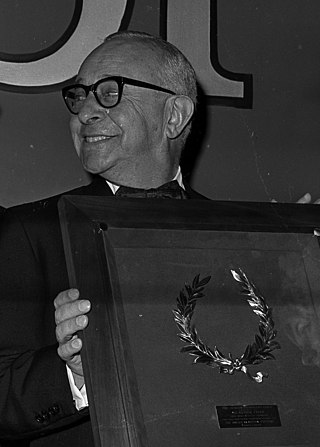
Arthur Freed was an American lyricist and a Hollywood film producer. He won the Academy Award for Best Picture twice, in 1951 for An American in Paris and in 1958 for Gigi. Both films were musicals, and both were directed by Vincente Minnelli. In addition, he produced the film Singin' in the Rain, the soundtrack for which primarily consisted of songs he co-wrote earlier in his career.
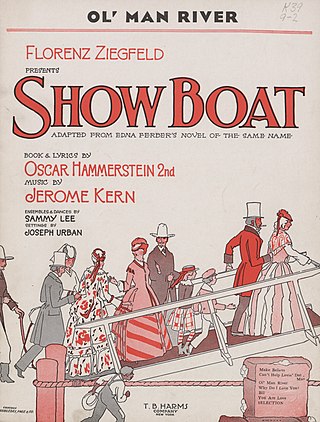
Show Boat is a musical with music by Jerome Kern and book and lyrics by Oscar Hammerstein II. It is based on Edna Ferber's best-selling 1926 novel of the same name. The musical follows the lives of the performers, stagehands and dock workers on the Cotton Blossom, a Mississippi River show boat, over 40 years from 1887 to 1927. Its themes include racial prejudice and tragic, enduring love. The musical contributed such classic songs as "Ol' Man River", "Make Believe", and "Can't Help Lovin' Dat Man".
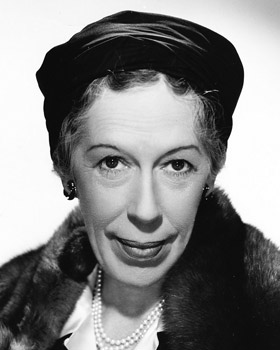
Edna May Oliver was an American stage and film actress. During the 1930s, she was one of the better-known character actresses in American films, often playing tart-tongued spinsters.
Show Boat is a 1936 American romantic musical film directed by James Whale, based on the 1927 musical of the same name by Jerome Kern and Oscar Hammerstein II, which in turn was adapted from the 1926 novel of the same name by Edna Ferber.

Show Boat is a 1929 American pre-Code sound part-talkie romantic drama film based on the 1926 novel Show Boat by Edna Ferber. The film initially did not use the 1927 stage musical of the same name as a source, but scenes were later added into the film incorporating two of the songs from the musical as well as other songs. Many of these songs from the stage show were featured in a special prologue that was added to the picture before it was released. This film was produced and released by Universal. Like the majority of films during the early sound era, a silent version was made for movie theatres that had not yet converted to sound.
"Can't Help Lovin' Dat Man" with music by Jerome Kern, and lyrics by Oscar Hammerstein II, is one of the most famous songs from their classic 1927 musical play Show Boat, adapted from Edna Ferber's 1926 novel.

Julie Gregg was an American television, film and stage actress.
Gaylord Ravenal is the leading male character in Edna Ferber's 1926 novel Show Boat, in the Jerome Kern-Oscar Hammerstein II musical of the same name based on the novel, and in the films and other adaptations of the story. He is a handsome, compulsive riverboat gambler, who becomes the leading man of the showboat Cotton Blossom at the same time that Magnolia Hawks, the captain's daughter, becomes the leading lady. In the novel, this happens several years after the illegally married mulatto Julie Dozier and her white husband Steve Baker have left the show on the boat. In the musical, it happens immediately after Julie and Steve are forced to leave the show. In the musical, Magnolia and Gaylord meet in the first scene of the show, before Julie and Steve leave, as Kern and Hammerstein wished to bring Gaylord into the story early. In the novel the two meet right after Gaylord is hired as leading man, long after Julie and Steve have left.
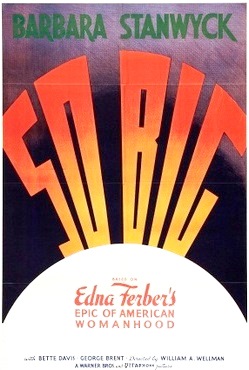
So Big is a 1932 pre-Code American drama film directed by William A. Wellman and starring Barbara Stanwyck. The screenplay by J. Grubb Alexander and Robert Lord is based on the 1924 Pulitzer Prize-winning novel of the same name, by Edna Ferber.

Show Boat is a 1951 American musical romantic drama film, based on the 1927 stage musical of the same name by Jerome Kern (music) and Oscar Hammerstein II, and the 1926 novel by Edna Ferber. It was made by MGM, adapted for the screen by John Lee Mahin, produced by Arthur Freed and directed by George Sidney.

Show Boat is a 1926 novel by American author and dramatist Edna Ferber. It chronicles the lives of three generations of performers on the Cotton Blossom, a floating theater on a steamboat that travels between small towns along the banks of the Mississippi River, from the 1880s to the 1920s. The story moves from the Reconstruction Era riverboat to Gilded Age Chicago to Roaring Twenties New York, and finally returns to the Mississippi River.
Mis'ry's Comin' Aroun' is a once-neglected song from the 1927 musical Show Boat by Jerome Kern and Oscar Hammerstein II. It was cut from the production during the Washington D.C. tryout on the orders of producer Florenz Ziegfeld, supposedly because it was one of the factors that made the show too long. However, musical theatre historian Miles Kreuger and conductor John McGlinn, also suggest that it was the dark, dramatic tone of the piece that most concerned Ziegfeld. Kern was reportedly so incensed by the deletion of "Mis'ry's Comin' Aroun'" that he made it the principal motif of Show Boats original overture and asked orchestrator Robert Russell Bennett to work sections of it into the background music as well, where it is now played by the orchestra during some of the dialogue scenes involving the mixed race actress Julie La Verne.
"Make Believe" is a show tune from the 1927 Broadway musical Show Boat with music by Jerome Kern and lyrics by Oscar Hammerstein II.
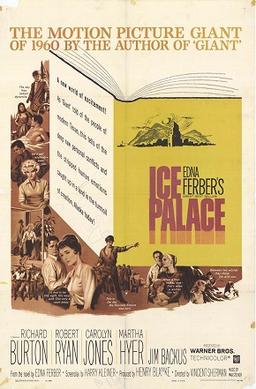
Ice Palace is a 1960 Technicolor historical drama adventure film directed by Vincent Sherman and adapted from a novel of 1958 written by Edna Ferber. The film stars Richard Burton, Robert Ryan, Carolyn Jones and Martha Hyer. It dramatizes the debate over Alaska statehood. Alaska had become a state in 1959.
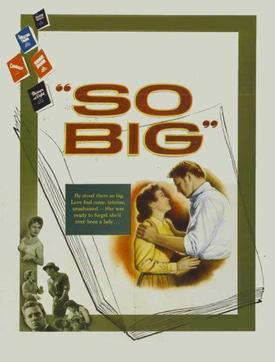
So Big is a 1953 American Drama Western film directed by Robert Wise and starring Jane Wyman, Sterling Hayden and Nancy Olson.
Julie Gilbert is a writer.

Diegetic music, also called source music, is music that is part of the fictional world portrayed in a piece of narrative media and is thus knowingly performed and/or heard by the characters. This is in contrast to non-diegetic music, which refers to incidental music or a score that is heard by the viewer but not the characters, or in musical theater, when characters are singing in a manner that they would not do in a realistic setting.
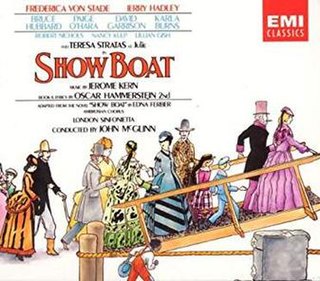
Show Boat is a 221-minute studio album of Jerome Kern's musical, performed by a cast headed by Karla Burns, Jerry Hadley, Bruce Hubbard, Frederica von Stade and Teresa Stratas with the Ambrosian Chorus and the London Sinfonietta under the direction of John McGlinn. It was recorded from June 1 to August 31, 1987 at Abbey Road Studios in London.
Stage Door is a 1936 stage play by Edna Ferber and George S. Kaufman about a group of struggling actresses who room at the Footlights Club, a fictitious theatrical boardinghouse in New York City modeled after the real-life Rehearsal Club. The three-act comedy opened on Broadway on October 22, 1936, at the Music Box Theatre and ran for 169 performances. The play was adapted into the 1937 film of the same name, and was also adapted for television.












